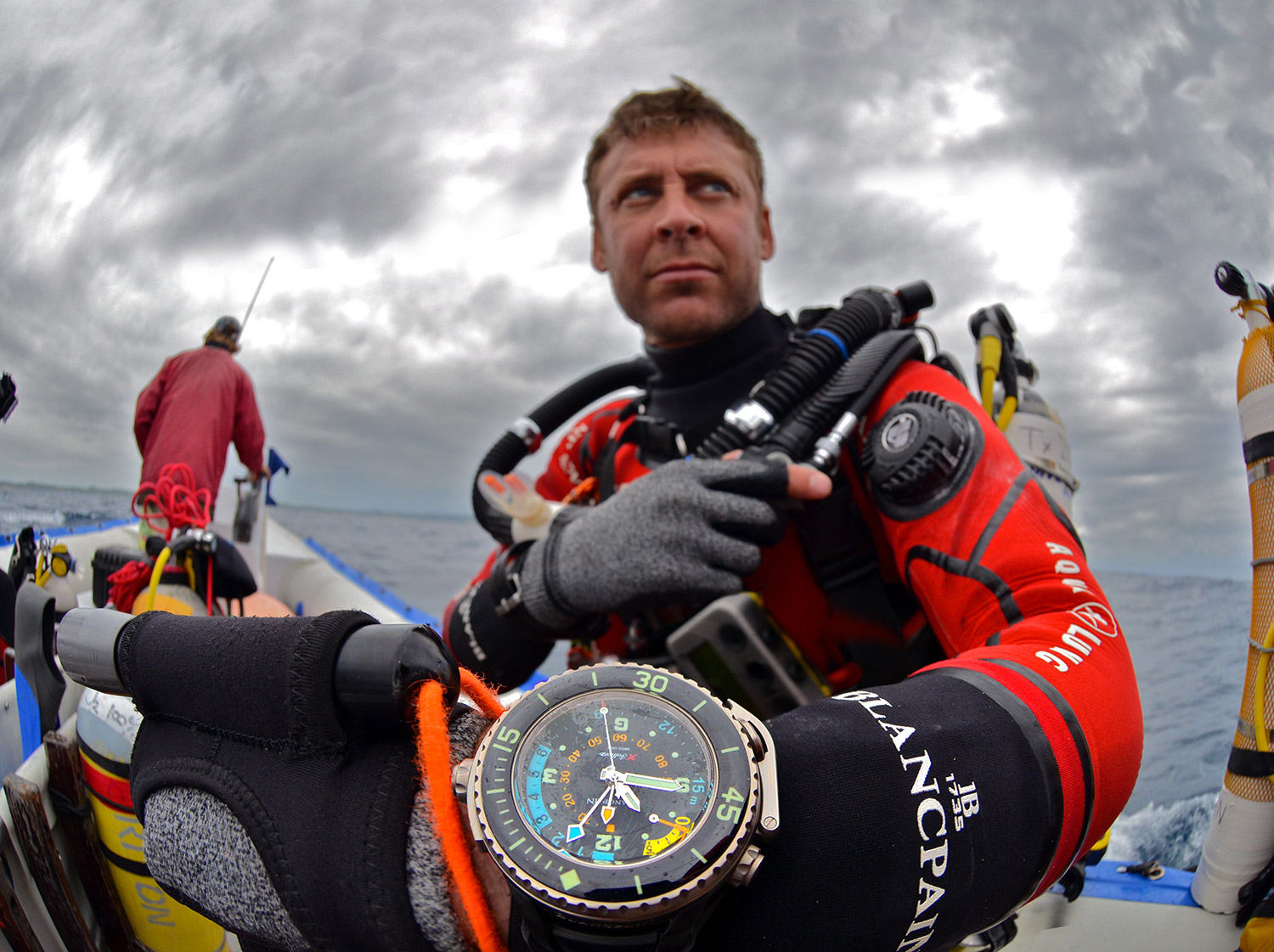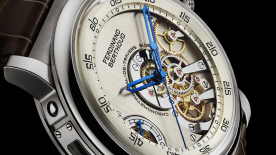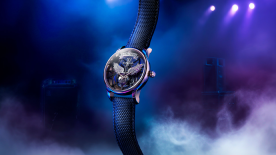At the inauguration of an exhibition at the Airside Centre in Zurich Airport dedicated to Blancpain’s Ocean Commitment, which is open until 12th February 2017, I was treated to an exclusive first showing of Laurent Ballesta’s breathtaking new documentary Antarctica, in the footsteps of the Emperor penguin, which was filmed in the Antarctic Ocean off France’s Antarctic research station an included a number of pioneering diving achievements. The documentary airs for the first time on the European channel Arte tomorrow at 8.50pm in French and German. Blancpain’s support for Laurent Ballesta’s expeditions is just one aspect of the brand’s Ocean Commitment programme in which it has invested several million Swiss francs over the past seven years.
Laurent, how do you prepare for such an expedition?
It took two years of preparation. We thought we would do it in one year but six weeks before we were due to leave there was a problem with our paperwork and we had to wait until the next season. But this allowed us to send some material in advance because there are a lot of logistics involved.
We sent a tracked vehicle, for example, which we had bought. We also bought a portable decompression chamber. In total around five tons of equipment was sent out. On site we had a hyperbaric doctor.
For the dives themselves we had closed air rebreather systems, which meant that we could stay in the water for up to six hours. We also had an electric heating system that kept our hands more or less warm. Even though they felt freezing cold we could still move our fingers so we had no excuse for leaving the water. So with a certain sense of responsibility and pride we pushed our own limits so that we were never the first person to resurface. This is how we managed to set some world firsts in polar diving. 
But surely the performance aspect was not the primary objective of the expedition?
Actually, in a way it was, because in the Antarctic, the deeper you dive, the more interesting it gets. In tropical regions it is exactly the opposite.
How important is Blancpain's support for you?
There is evidently a huge financial outlay necessary for such expeditions, so Blancpain’s support is important for this reason alone. Neither myself nor French TV could finance this kind of expedition on our own. But beyond that there is a very serious dimension to the brand. If I was sponsored by another brand things would be different. I might not have the same credibility vis-à-vis researchers, for example, or intellectual TV channels such as Arte, who will show the documentary. It’s flattering for me because it is a prestigious brand. The partnership also works very well because Blancpain watches have elements of technology but also art and craftsmanship. This is exactly the same mix that I find in my own work. This brings us closer together.
Alain Delamuraz, Blancpain’s Vice-President of Marketing, has said that the most important thing about the brand’s involvement with the ocean is that it brings concrete results, citing the three million square kilometres of ocean that have been protected. What results did your expedition bring to you personally?
In some cases it’s too early to say because scientific research takes a while to publish. There is peer review and there are protocols to be respected. But from the outset we knew we would be contributing to science, because the French Institute for Polar Research offered us eleven berths. We must not forget that these eleven berths were effectively taken from other researchers. All French researchers, and even researchers from other countries, can submit their research projects to the institute for consideration. If accepted the institute pays all their expenses. It is the first time that people like us have been welcomed on to the base, so it’s clear that there was a scientific interest from the start. Obviously there is a public relations dimension, too, but the commitment was that all images, after their commercial use in the film, were given to the scientific community free of copyright. So last month, once we had finished the film, we sent them a package of 800 photos and full descriptions from our dives. Many of the species were known, but only from dead animals. In most cases it was the first time that they had been seen in their natural environment. For example, the crab living inside the jellyfish that you see in the film were both known species, yet no one knew that the crab actually lived inside the jellyfish.
How do you communicate with your team under water?
First of all, we all know what we are doing and once we are under water we actually manage to communicate and even speak to each other. Because we are using rebreathers there are no bubbles, so even though we have something in our mouths we can still speak, as long as we keep things simple. Our voices actually travel quite far.
Many divers rely on a mechanical diver’s watch as a safeguard, since its traditional technology does not require and electricity or electronics. But your drysuit is 5mm thick and your wetsuit 12mm thick. Can you fit a Blancpain watch around all that?
Unfortunately not, but I always have my X-Fathoms in my pocket! When I was a child, people used to tell me that dive computers would never catch on because you cannot take electronics underwater. The X-Fathoms is still my back up. The dive computer gives me an enormous amount of information. Not just the time and the depth but it also analyses in real time the mixture of gases that I am breathing and continuously adjusts the mixture according to depth and programs my decompression stages. This is all vitally necessary, of course, but if there is a big problem I only need two things to save my life: time and depth. If the electronics fail, the X-Fathoms gives me both and I know it will get me out of a tricky situation. 
Are you already planning your next expedition?
Yes, things are already in motion. One of the team is looking for the necessary boats and we are going to return to the location of the second expedition in 2014 to film the sequel. I want to film sharks hunting in groups at night to see whether there is a pattern or tactics. People talk about the frenetic hunting of sharks and the fact that they go mad if you put just a drop of blood into the sea but I don’t think this corresponds to the reality and I think they are actually much better organised.





